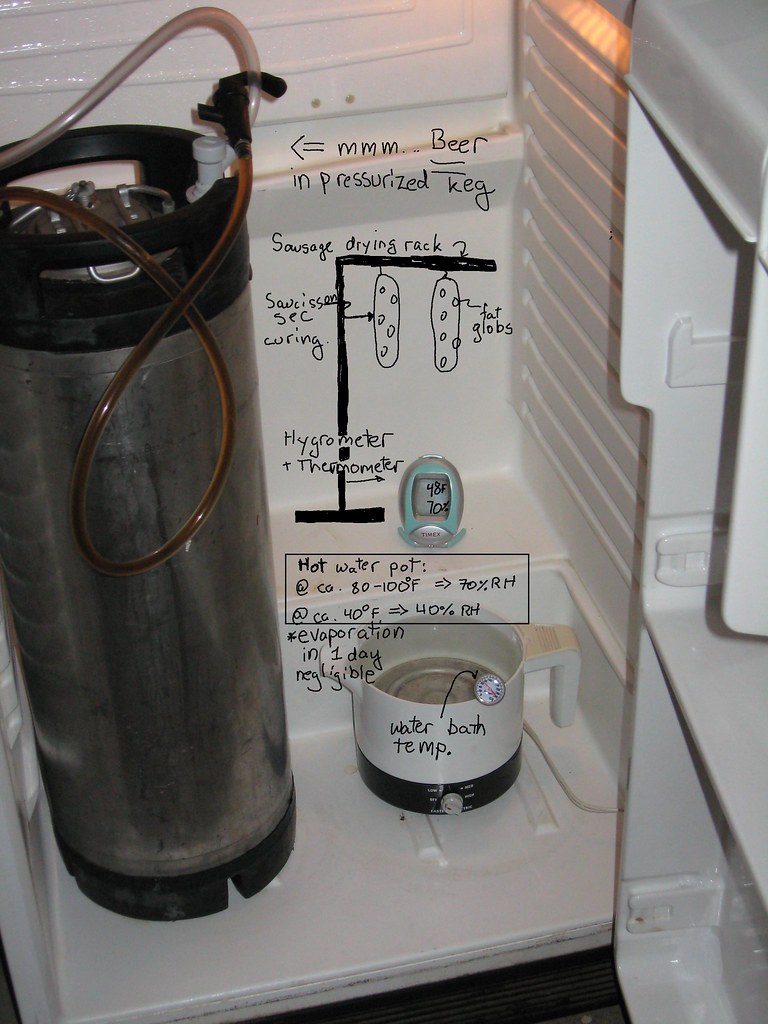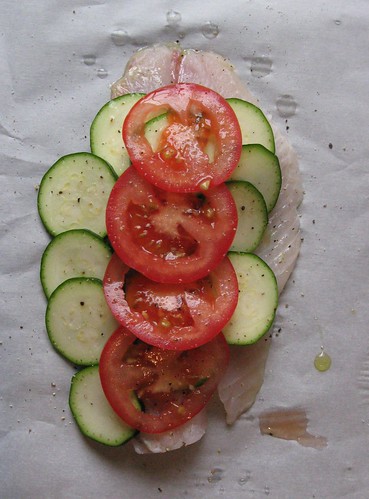This morning at Weiland's I got some nice young stalks of rhubarb for an interesting salad (by Wolfert), spanish (sweet) smoked paprika, chicken parmesan & spinach sausage (for a dish of greens and garbanzos this week) and HOG CASINGS!
Hog casings are currently $18/lb! Same as Reggiano. Fortunately, 1/18th lb. will suffice for 4 lbs. of sausage (thanks Mac for the idea). The butchers seemed happy to support a newbie sausage maker. All that and free coffee. A fun market indeed.
5.31.2008
Not quite the farmer's market, but ...
5.28.2008
Dry Curing: Environment Variable Tweaking
My recent food preoccupation has been the sausage. I've been engrossed in Ruhlman's Charcuterie to get familiar with the subject. A few things appear crucial to making sausage. It requires a good source of pork. I plan on finding it at North Market when I get to my first run. Also crucial to the craft is attention to sanitation and accurate measurement.
My first run will likely be a dry cured sausage which requires a 60°F and 60-70% relative humidity (RH) atmosphere. I found a spot in my basement that runs 57-65°F and the chamber I'm using has a layer of saturated salt solution in it. This should give me an equilibrium RH of 72%. It's also open to the dryer air in the basement, in case I need some circulation. 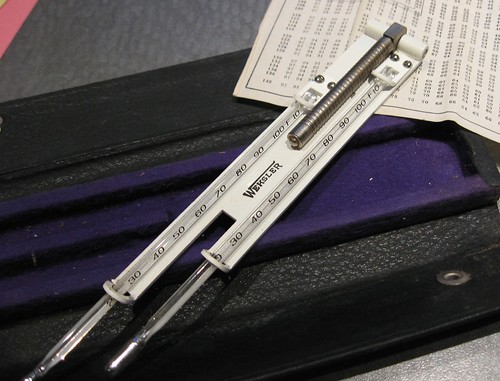
I know my family will express their unconditional love for me by tasting my creations, but I'm going the extra mile and am going to make my measurements as accurately as possible.
To that end, I used a sling-psychromoter for the determination of RH. It's one of the most primitive, yet most accurate methods for measuring temperature and RH. It's a bit of a pain to use, so I'm using it as a primary standard to calibrate my other devices. I bought a wireless Honeywell thermo-hygrometer and used the sling-psychrometer (depicted above) to do a single point calibration. It was spot on. Then, I set the wireless module in my curing chamber and was able to achieve the results shown below. A tad below the theoretical 72% RH that a salt solution should give, but it was open to air in my basement (52%RH), so it's reasonable.
If I need to get a bit cooler, I can wrap my chamber with a wick (cotton cloth dipped in water) and cool it another 10 degrees or so by evaporative cooling. All with no added energy!
I am sooo ready. Just need some curing salt #2 and I'm off and running! You just can't find tedious passages like this in books folks.
5.25.2008
Big Grain Waffles
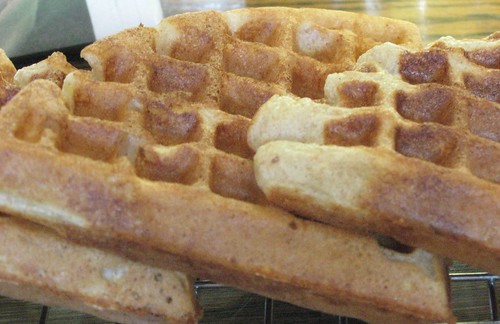
Got this recipe on food.yahoo.com. Been waiting a couple weeks to try it. Not bad. Because of all the big grains, most of them weren't super crunchy, but they were very flavorful. All we topped them with was peach preserves from the Clintonville Community Market. Made a bunch extra to freeze for weekday b'fasts.
5.22.2008
Saucisson sec preparation
Before tackling Ruhlman's saucisson sec, I needed a place for the sausage to undergo curing for about 3 weeks at 50°F and at least 60% relative humidity (RH). My beer fridge usually only has a single keg in it and I decided to tweak this chamber a bit to see if I could achieve a steady temperature/RH.
Baseline for the beer fridge is 45°F and 30-35% RH. Too dry. I thought some water in the bottom might increase the humidity. It did, to about 40%. After a number of different substrates placed in the fridge failed, I thought about increasing the water temperature by using a variable temperature hot pot. It's not a trivial problem. The fridge has a thermostat, the hot pot at a higher temperature will cause an increase in the vapor pressure of the water resulting in a higher humidity and finally the interdependence of the temperature and relative humidity make this environment nearly impossible to predict or calculate outcomes.
Empiricism to the rescue. I was able to fine tune both the fridge setting and hot pot setting to achieve the following boundary conditions:
38-40°F/40%RH with the hot pot on lowest setting (off)
48-50°F/68-70%RH with the hot pot at 90°F.
Also, at 90°F, the water barely evaporates over the course of 24 hours.
I have to have that kind of flexibility because of what Andrew warned me of. When the fresh sausage goes in for a cure, it loses water over time, thus increasing the humidity inside the chamber. Consequently, I need to be able to decrease the humidity contributed by the water bath to maintain a constant interior RH as the sausage cures.
I have some long term monitoring to do to validate the setup, but I'm confident enough, and the sausage ingredients are inexpensive enough to take a stab at it. Andrew, I may take you up on your generosity of the sausage stuffer loan, I can't wait any longer.
5.20.2008
Tilapia en papillote
Years ago while visiting a friend in Dijon, she made us a splendid meal in minutes from a few fish fillets and some veggies in her fridge. Layering a cleaned fillet with veggies and flavoring each layer with a dash of salt and pepper, dotting the whole mixture with lemon juice and olive oil and baking gave us a lovely fresh meal served with rice. Here's my attempt at recreating the special meal we had.
The only thing missing from the image is a topping with a chiffonade of fresh basil.
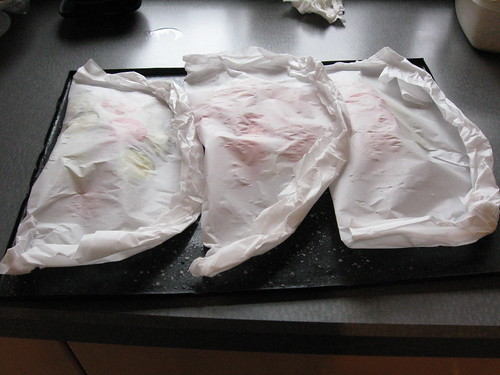
I wrapped and crimped the parchment to contain the fish and veggies and went on to preheat the oven and prepare the brown basmati side. The oven was preheated to 450-deg-F and the sheet tossed in the oven for about 15 minutes. The baking sheet was removed using a pizza peel revealing 3 pouches speckled with burn marks, but still nicely sealed and smelling wonderful. I let the pouches rest a few minutes and opened mine as a test case to make sure the fish was cooked properly. It flaked nicely and the aroma was enticing. The lemon and steamed zucchini and tomatoes laced with basil made me especially hungry.
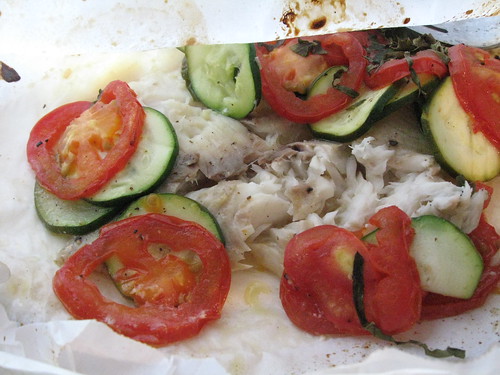
Here's a view of my packet opened. I slid the food off on to the plate. It was a lovely fresh tasting meal we will enjoy again.
5.18.2008
On mindfulness and diet: it's about balance
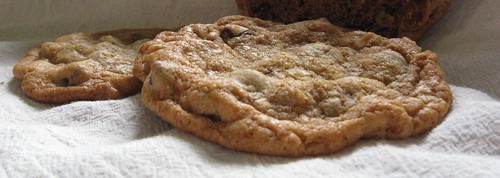
Mrs. Dave's Beer and I have recently come face to face with the harsh reality that our metabolism is slightly different than it was when we met, in our twenties. At the beginning of the year, we suddenly realized, our portion size was too big, the beloved meat portion dominated the plate and desserts were too common. We needed to take action and didn't want to give up good food.
Within a month we:
• Reduced the portion size of our meal, especially pasta.
• The presence of a vegetable on our plate was NOT an option, but has become a front and center part of the meal leaving the delectable meat portion the dinner-version of a dessert; something to appreciate and savor.
• The starch portion: whether it be pasta or rice has become a much more complex form of grain; a whole wheat couscous, a brown basmati /orzo pilaf, etc. Good alternatives are abundant.
• Legumes are a frequent replacement for meat, lentils especially. Cooked and spiced properly, they are a perfect protein component as satisfying as meat.
• While we're not enemies of enriched unbleached white (I still buy mine in 25 lb bags), we've always been aware of the problem with stripped down unbleached white being the foundation of too many preparations. One minor counter of this, we started having a variety of whole grain cooked cereals for breakfast (an unbelievably nice change) instead of white flour pancakes.
• Incorporating whole grains into fresh pasta (dry and fresh).
• Substitution of a fraction of the unbleached white with a higher grain. While this may bring back flashbacks of the disasters of substituting fat with apple juice concentrate in bran muffins, it is often a substitution yielding great results.
• Fruit is abundant in our home and always available for snacking. Frankie enjoys a ripe kiwi fruit or banana as much as a crappy corn syrup-based Spiderman gummy treat. She gets the latter on occasion, she's a kid.
There are many other alterations to our diet we've made that are not only healthy, but better, give us more variety and are easy to maintain. These changes are part of a permanent change in our lives and we're enjoying food more than ever. Since January, we've lost only a few pounds, but, more importantly, stemmed a scary trend we nearly gave in to as inevitable.
Why the cookie image at the top of the post? Desserts are not only allowed in our diet, but special. These cookies are simply the Toll House recipe on the back of the semi-sweet chip bag - butter and all. These were made by Frankie under the tutelage of Mrs. Dave's Beer substituting only one thing. King Arthur's white whole wheat (a flour I'm enjoying the more I used it, available at Weiland's) for half of the flour bill. Although these cookies are hardly healthy, the substitution afforded a serendipitous benefit. They were actually better than the original. They taunt us whenever we go into the kitchen.
We gave away tons and still have too many on hand. I'm afraid they won't go to waste. It's a bit decadent, but the diet's still reasonably balanced.
5.11.2008
Charcuterie, A book that will change my life (a little).
"Embrace the sausage." p. 100
Cookbook authors are notorious for making unsubstantiated, general statements. They are often authoritative sounding, but hardly methodological. I haven't purchased a cookbook in years. I recently borrowed Ruhlman and Polcyn's Charcuterie: The Craft of Salting, Smoking, and Curing. This is more of a fun text than it is a cookbook. Soon, I'll have to buy it.
The chapter on sausage making is worth the price of the book. The authors are rigorous in their safe preparation of the tastiest and least expensive cuts of meat. A central theme in the book is flavorful, but tough, fatty cuts of meat can be tenderized by mechanical means as an alternative to long cooking methods like braising. I learned grinding meat isn't just pounding a piece through the grinding attachment of your Kitchen Aid (I can assure you, that careless approach does NOT work). It requires attention to sanitation, careful measurement and temperature control. They use mass rather than volumetric measurement throughout the book, essential to any accurate preparation description. The techniques aren't hard, but attention to them will result in a truly special piece of meat rather than relying on the corporate-level sausage skills of the big meat houses.
Just a few items I can't wait to do or have already found indispensable:
• A Carolina tangy barbecue sauce (it's already on my stove).
• Brining times based on cut of meat.
• How to make jerky from venison (we have a ton of venison on hand).
• Making pancetta from $2/lb pork belly.
• Merguez preparation (although Mediterranean Imports makes a great one).
• Grinding my own turkey breast for my special meatballs.
• Room temperature fermentation of vegetables to pickled vegetables.
• and soooo much more, can't wait to try more of the preps.
5.04.2008
Brined and hickory smoked
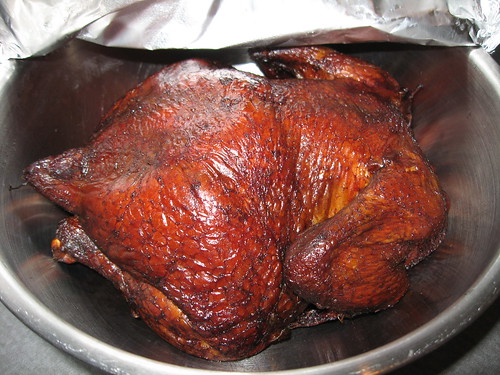
Last weekend and today, I scraped paint. Dangling from a 12' ladder (I know, pretty low, but I was practically frozen with fear), somehow I managed to save my emergency room $50 copay and stayed healthy. While scraping, I had my Weber working diligently for me while I cooked for the week.
I started with a dirt cheap chicken from Aldi. It was pretty frozen, even after a day in the fridge, it was still rock hard frozen. While I don't often brine anything with a bone in it, I took Andrew's advice and used a brine to both keep it moist and thaw it out. About 12 hours in the fridge, sitting in a brine (4T salt + 4T brown sugar/quart of water) thawed it out perfectly. I removed the bird, dabbed it dry, coated it with olive oil, lemon juice, salt, pepper and stuffed the cavity with herbs (rosemary, thyme, basil) and tossed it on the grill.
For this smoke session, I used some no name lump I bought at Weiland's mixed with pieces of hickory. A small pile of fuel (ca. 20 pieces and replenished with about 10 pieces after a couple hours or so) went for about 4-5 hours at a steady 300-deg-F. Unfortunately, I was pretty absorbed scraping and let the chicken go about 3 hours. I suspect it only needed about 2. Brine to the rescue! This is after the smoking.
I wrapped the bird (cooked last Sunday) and tossed it in the fridge. We didn't get to it until Wednesday. And, wow, was it nice. Light smoke flavor, moist and fell off the few bones holding it together. Nearly pulled chicken. We usually use a chicken for a regular dinner with roasted potatoes and veggies and the rest of the meat gets vacuum packed for a smoked chicken salad later. Both meals are amazing. Chicken is one of the easiest and best 'q preps. Nearly impossible to screw up, good yield, only takes a couple hours indirect (depending on your temp). We never get tired of this staple. I might reconsider brining even bone in chicken and pork. Got a mean looking picnic ready to go in my freezer.
Upcoming? Jim @ CMH Gourmand will be interviewing me for a podcast on his site. [Dave @ davesbeer.com for book deals. ]

